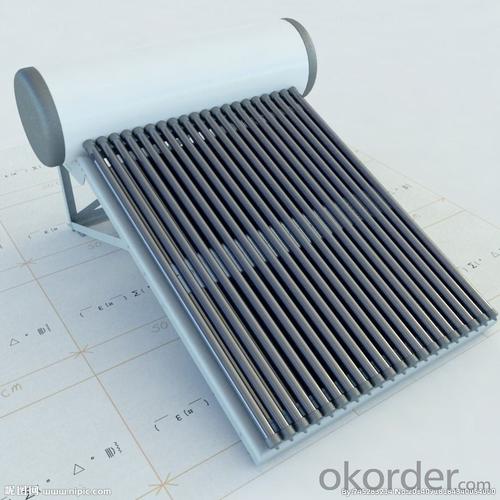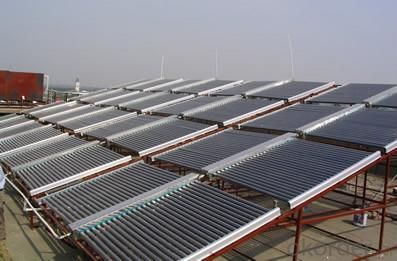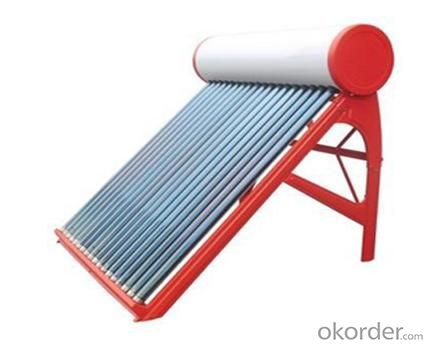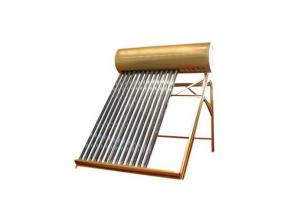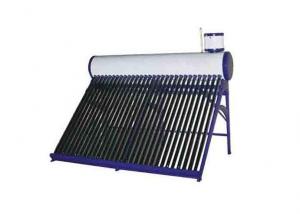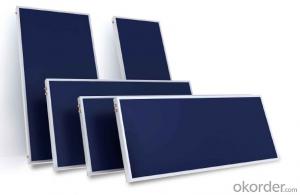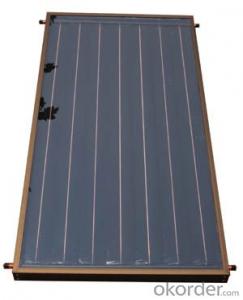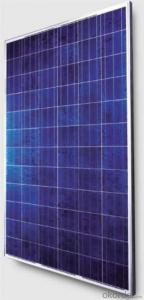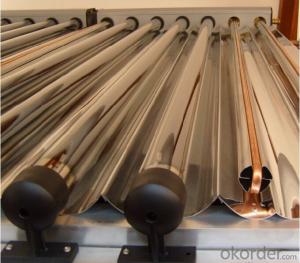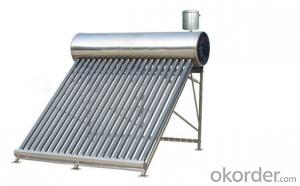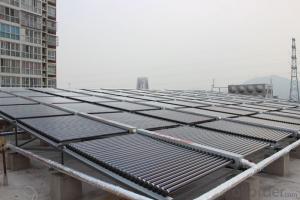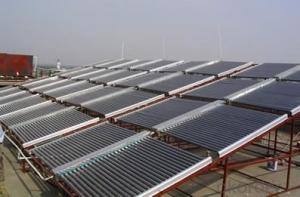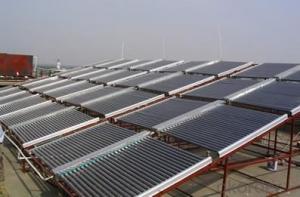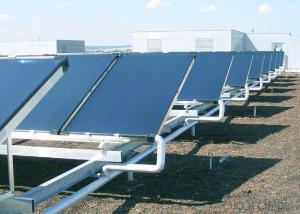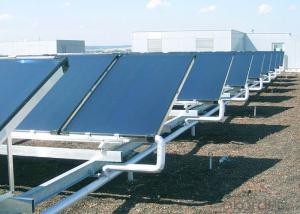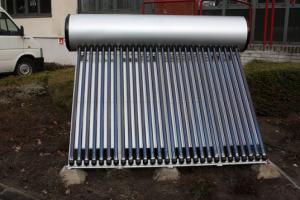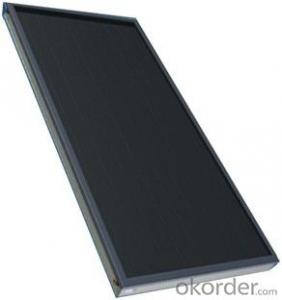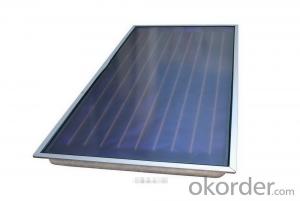Parabolic Solar Collectors Non-Pressurized Heat Pipe Solar Water Heater System
- Loading Port:
- China main port
- Payment Terms:
- TT OR LC
- Min Order Qty:
- 1 set
- Supply Capability:
- 6000 set/month
OKorder Service Pledge
OKorder Financial Service
You Might Also Like
Introduction of Non-Pressure Solar Water Heater:
Non-pressure Solar Heater is one of the most economical solar water heating device with pretty high efficiency at the same time. It consists of hot water storage tank, solar vacuum tubes with mouth plug in storage tank, and bracket supporting tank and tubes.When cold water in evacuated tubes is heated with solar irradiation, as the specific gravities of hot water and cold water are different, hotter water goes upward to storage tank and colder water goes downward to glass tubes. through this continuous circulation, the cold water in storage tank will be gradually heated till sunset.
Specialty:
1. High thermal performance and working temperature: the heat exchanging rate even in winter can up above 55%.
2. Heat collecting efficiency is at least 20% above common solar systems.
3. Work in all day and all season: no matter any corner of the world, this system can work well even -40℃ to avoid the tube freezing problem.
4. Reliability: No water following through the tube, so water scale can not generate and tube cracks could be avoided, the system still can keep working even with some damaged tubes.
5. It can connect with water tap and work automatically with pressure0.6Mpa, bring enjoyable washing experience.
6. Safety: P/T valve would release pressure and temperature to protect tank..
Technical Specification:
1. Outer tank material: SUS304 stainless steel or powder coated color steel
2. Inner tank material: 1.2mm thick SUS304 food grade stainless steel ( Optional material SUS316L)
3. Vacuum tube material: borosilicate glass 3.3; AL-SS-CU absorb coating, with copper heat pipe inside
4. Frame material: 1.2mm thickness stainless steel
5. Insulation material: 55mm thickness polyurethane
6. Suitable for mains pressure water(up to 8 bar/116psi)
7. Easy plug-in installation
8. Install the T/P valve on the pressurized tank
9. Seal material: Stabilized High Temperature Silicon
Outer tank material: SUS304 stainless steel or powder coated color steel
Inner tank material: 1.2mm thick SUS304 food grade stainless steel ( Optional material SUS316L)
Vacuum tube material: borosilicate glass 3.3; AL-SS-CU absorb coating, with copper heat pipe inside
Frame material: 1.2mm thickness stainless steel
Insulation material: 55mm thickness polyurethane
Suitable for mains pressure water(up to 8 bar/116psi)
Easy plug-in installation
Install the T/P valve on the pressurized tank
Seal material: Stabilized High Temperature Silicon
19. Vacuum Tube | 20. Size (mm) | 21. Φ47*1500 / Φ58*1800 / Φ70*2100 | |||||
22. Tube (pcs) | 23. 10 / 12 / 15 / 18 / 20 / 22 / 24 / 30 / 36 / 42 | ||||||
24. Material | 25. Borosilicate 3.3 glass, magnetron spluttering selective coating | ||||||
26. Coating | 27. Single-target AL-N/AL or Three-target AL/N-Cu-SS | ||||||
28. Water Tank | 29. Capacity | 30. 80L ~ 500L for hot water storage tank | |||||
31. Inner tank | 32. Food-grade stainless steel SUS304-2B / SUS316 | ||||||
33. Insulation | 34. High-density polyurethane foam with 70~80 hour heat preservation | ||||||
35. Tank shell | 36. Food-grade stainless steel SUS304-2B | ||||||
37. Bracket | 38. Shaped strong aluminum alloy structure adaptable for flat or slope roof | ||||||
39. Accessories | 40. Anti-aging silicon seals, Dustproof seals, Air-vent cap, Stainless screws | ||||||
41. Auxiliary Devices | 42. Assistant tank, Intelligent controller, Electrical heater, Magnesium anodes | ||||||
43. Tilt Angle | 44. 25 ~ 50° | ||||||
45. Water Output | 46. 45 - 95°C | ||||||
47. Hail Resistance | 48. Φ25mm diameter | ||||||
49. Model Number | 50. Solar Vacuum Tube | 51. Tank 52. Liter | 53. System 54. Liter | 55. Container Loading Qty /sets | |||
56. Size /mm | 57. Qty /pcs | 58. 20GP | 59. 40GP | 60. 40HQ | |||
61. VNS-58SA12-100 | 62. Φ58*1800 | 63. 12 | 64. 100 | 65. 132 | 66. 58 | 67. 119 | 68. 140 |
69. VNS-58SA15-130 | 70. 15 | 71. 130 | 72. 170 | 73. 54 | 74. 108 | 75. 131 | |
76. VNS-58SA18-150 | 77. 18 | 78. 150 | 79. 198 | 80. 43 | 81. 86 | 82. 105 | |
83. VNS-58SA20-170 | 84. 20 | 85. 170 | 86. 223 | 87. 40 | 88. 80 | 89. 97 | |
VNS-58SA24-200 | 24 | 200 | 263 | 35 | 70 | 85 | |
VNS-58SA30-250 | 30 | 250 | 329 | 28 | 56 | 68 | |
VNS-58SA36-300 | 36 | 300 | 395 | 23 | 47 | 57 | |
Product Show
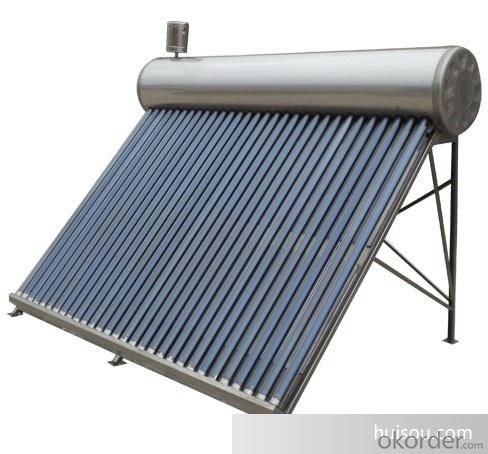
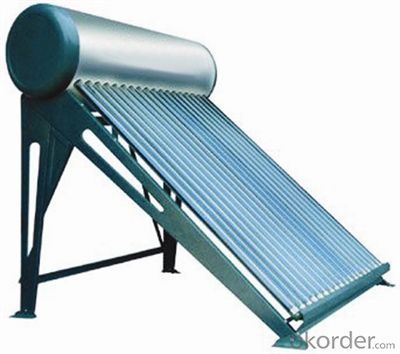
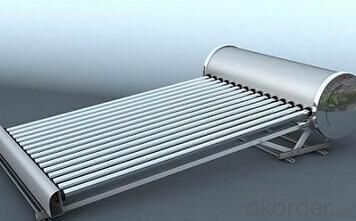
Our Services
1. OEM service
2. Warranty: 5 years
3. Considerable after sale service
Color steel Compact pressure Thermal solar heater
FAQ:
1. What’s the delivery time?
10 days after receiving deposit.
2. How long is the warranty?
5 years for whole system, 1 year for accessory
3. What’s your production capacity?
6000sets/month
4. What’s the MOQ?
1 set.
5. What’s your payment term?
Container: 30% T/T in advance for deposit, 70% T/T before shipment for fist order.
70% T/T after seeing copy of B/L from second order
Sample: 100% T/T in advance
Other choices: L/C at sight.
6. What certifications do you have?
CE, SOLAR KEYMARK, SRCC and etc.
- Q: Can solar collectors be used for industrial purposes?
- Yes, solar collectors can be used for industrial purposes. They can be employed to generate heat or electricity for various industrial applications such as heating water, powering machinery, or providing energy for manufacturing processes. Solar thermal systems, which use solar collectors, are particularly useful in industries that require significant amounts of heat, such as food processing, chemical production, or textile manufacturing. Additionally, solar photovoltaic (PV) systems can be utilized to generate clean electricity for industrial operations, reducing reliance on fossil fuels and lowering carbon emissions.
- Q: What is the difference between flat plate and evacuated tube solar collectors?
- The main difference between flat plate and evacuated tube solar collectors lies in their design and efficiency. Flat plate collectors consist of a dark-colored plate that absorbs sunlight and transfers the heat to a fluid circulating within pipes. On the other hand, evacuated tube collectors are composed of a series of glass tubes, each with a smaller glass tube inside it, creating a vacuum to minimize heat loss. In terms of efficiency, evacuated tube collectors generally perform better in colder climates and during cloudy days due to their ability to capture more heat and minimize heat loss. They also have a higher operating temperature range and can generate higher temperatures. Flat plate collectors, however, are more cost-effective and suitable for warmer climates where high temperatures are not required. Moreover, evacuated tube collectors tend to have a longer lifespan and are less prone to damage from freezing or overheating since each tube can function independently. Flat plate collectors, on the other hand, are simpler in design and easier to install and maintain. Overall, the choice between flat plate and evacuated tube collectors depends on factors such as climate, desired operating temperatures, cost, and installation requirements.
- Q: What are the different types of solar collectors?
- There are several types of solar collectors, including flat plate collectors, evacuated tube collectors, and concentrating collectors.
- Q: Can solar collectors be used in areas with high temperatures?
- Yes, solar collectors can be used in areas with high temperatures. In fact, solar energy systems generally perform better in higher temperatures as they rely on sunlight to generate electricity or heat water. However, it is important to design and install solar collectors properly to mitigate any heat-related challenges such as overheating and reduced efficiency.
- Q: Can solar collectors be used for heating churches and religious buildings?
- Yes, solar collectors can be used for heating churches and religious buildings. Solar thermal systems can be installed on rooftops or other suitable locations to capture the sun's energy and convert it into heat. This heat can then be used for space heating or to heat water for various purposes within the building. Utilizing solar collectors for heating such buildings not only reduces energy costs but also aligns with the principles of sustainability and environmental stewardship often associated with religious institutions.
- Q: What is the impact of altitude on solar collector performance?
- The impact of altitude on solar collector performance is primarily related to the reduction in air density at higher altitudes. This decrease in air density leads to a lower heat transfer coefficient, resulting in reduced heat transfer efficiency of the solar collectors. Additionally, the decrease in atmospheric pressure at higher altitudes can affect the boiling point of the heat transfer fluid, potentially leading to operational challenges. However, the impact of altitude on solar collector performance can vary depending on factors such as the type of collector, location, and design considerations.
- Q: Can solar collectors be used in public transportation?
- Yes, solar collectors can be used in public transportation. Solar panels can be installed on buses, trams, and trains to generate electricity and power various systems on board, such as lights, air conditioning, and electronic displays. This helps reduce dependence on fossil fuels, lowers emissions, and contributes to a more sustainable and environmentally friendly public transportation system.
- Q: Are solar collectors suitable for office buildings?
- Yes, solar collectors are suitable for office buildings. Installing solar collectors on office buildings can provide numerous benefits. Firstly, solar collectors can generate clean and renewable energy, reducing the office building's reliance on traditional fossil fuel-based electricity. This not only helps to reduce carbon emissions and combat climate change but also lowers energy costs in the long run. Additionally, solar collectors can help office buildings achieve energy independence, reducing their vulnerability to power outages or fluctuations in energy prices. By utilizing solar energy, office buildings can become more self-sufficient and resilient. Moreover, solar collectors can enhance the sustainability image of office buildings, showcasing a commitment to environmental responsibility. This can attract environmentally conscious tenants and employees, positively impacting the building's reputation and potentially increasing its value. Furthermore, solar collectors can contribute to achieving energy efficiency in office buildings. By harnessing the sun's energy, solar collectors can provide heating, cooling, and electricity, reducing the need for traditional HVAC systems and lighting. This can lead to significant energy savings and lower operating costs for office buildings. In conclusion, solar collectors are highly suitable for office buildings due to their ability to generate clean energy, increase energy independence, improve sustainability, and enhance energy efficiency.
- Q: Can solar collectors be used in healthcare facilities?
- Yes, solar collectors can be used in healthcare facilities. Solar collectors can be used to provide hot water and space heating, which are essential for various healthcare facilities such as hospitals, clinics, and nursing homes. Implementing solar collectors can reduce the reliance on traditional energy sources and lower energy costs, making it an environmentally friendly and cost-effective solution for healthcare facilities.
- Q: Can solar collectors be used for heating sidewalks?
- Yes, solar collectors can be used for heating sidewalks. Solar collectors can absorb sunlight and convert it into thermal energy, which can be used to heat a fluid or directly warm surfaces such as sidewalks. This technology, known as solar radiant heating, can help melt snow and ice on sidewalks, providing safer walking conditions during winter.
Send your message to us
Parabolic Solar Collectors Non-Pressurized Heat Pipe Solar Water Heater System
- Loading Port:
- China main port
- Payment Terms:
- TT OR LC
- Min Order Qty:
- 1 set
- Supply Capability:
- 6000 set/month
OKorder Service Pledge
OKorder Financial Service
Similar products
Hot products
Hot Searches
Related keywords






